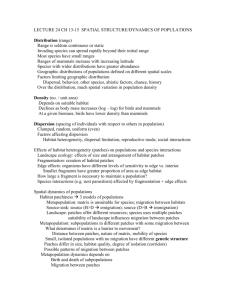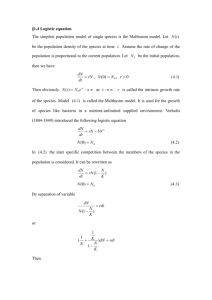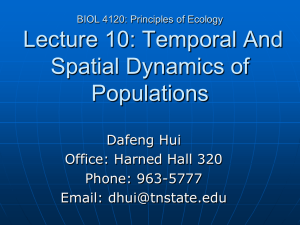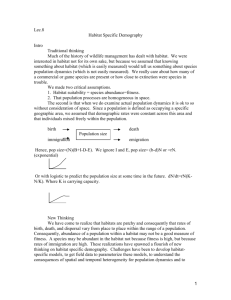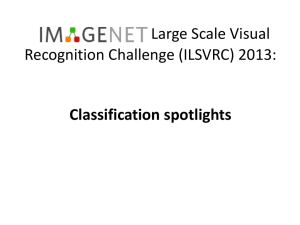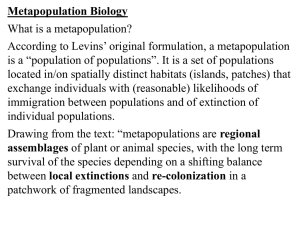PowerPoints
advertisement
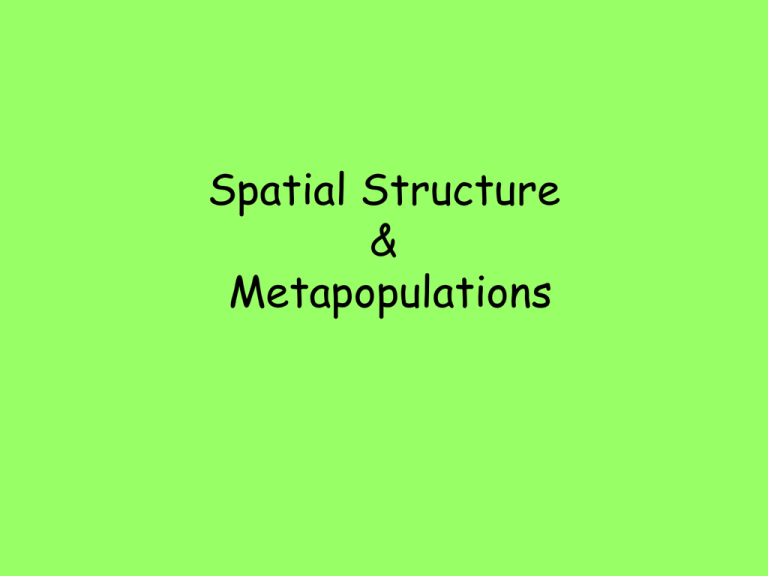
Spatial Structure & Metapopulations Clematis fremontii Erickson 1945 Dispersion of Individuals within Populations • Dispersion of individuals within a population describes their spacing with respect to one another. • A variety of patterns is possible: – clumped (individuals in discrete groups) – evenly spaced (each individual maintains a minimum distance from other individuals) – random (individuals distributed independently of others within a homogeneous area) Desert shrubs can be nearly regular in distribution Aspen in the Rocky Mountains are clonal Causes of Dispersion • Even spacing may arise from direct interactions among individuals: – maintenance of minimum distance between individuals or direct competition for limited resources may cause this pattern • Clumped distribution may arise from: – social predisposition to form groups – clumped distribution of resources – tendency of progeny to remain near parent • Spatial pattern is scale-dependent Clematis fremontii Erickson 1945 Populations exist in heterogeneous landscapes. • Uniform habitats are the exception rather than the rule: – most populations are divided into subpopulations living in suitable habitat patches • Degree to which members of subpopulations are isolated from one another depends on: – distances between subpopulations – nature of intervening environment – mobility of the species Metapopulation Model • The metapopulation model views a population as a set of subpopulations occupying patches of a particular habitat: – intervening habitat is referred to as the habitat matrix: – the matrix is viewed only as a barrier to movement of individuals between subpopulations Metapopulation models: applications in conservation planning and management. • As natural populations become increasingly fragmented by human activities, ecologists have turned increasingly to the metapopulation concept. • Two kinds of processes contribute to dynamics of metapopulations: – growth and regulation of subpopulations within patches – colonization to form new subpopulations and extinction of existing subpopulations Southern California Spotted Owl Connectivity determines metapopulation dynamics • When individuals move frequently between subpopulations, local fluctuations are damped out. • At intermediate levels of movement: – the metapopulation behaves as a shifting mosaic of occupied and unoccupied patches • At low levels of movement: – the subpopulations behave independently – as small subpopulations go extinct, they cannot be reestablished, and the entire population eventually goes extinct Local extinction • Regional extinction is the probability that the population goes extinct. • Local extinction is the probability that the part of the population in an occupied patch does extinct = pe • Probability of persistence for n years = probability of no extinction for n years in a row = (1-pe)n • pe = .7, n = 5 , survival = .00243 Regional persistence • Consider x independent patches • Probability of persistence in one patch = 1 - pe • Probability of persistence in at least one patch is one minus probability they are all extinct = 1 – pe x • pe = .7, t = 10 patches, survival = .97 The metapopoulation model • f = fraction of sites occupied (0-1) • I = Immigration rate (or colonization rate) • E = Local extinction rate • df/dt = I-E Probability of local colonization • Physical conditions • Biological conditions (preditors, pathogens, competitors) • Patch size • Patch isolation • Proximity to occupied patches • I = pi(1-f) Basic model • Extinction rate is the product of probability local extinction rate times the fraction of sites occupied = pef • Extinction rate is 0 if pe or f is 0 • df/dt = pi(1-f) –pef • The simplest model Assumptions to relax? • Homogeneous patches (size, isolation, quality, resource levels, etc) • No spatial structure (no neighborhoods) • No time lags (instantaneous response) • Constant pe and pi • Relationships can exist between regional occurrence and local colonization and extinction • Large number of patches (no demographic stochasticity) Island model • Probability of immigration is fixed. Propagule rain fixed by a constant, large source population. • df/dt = pi(1-f)-pef • df/dt = 0 pi - pif –pef = 0 • f = pi / (pi+pe) [always positive] Internal colonization • Only source of propagules is occupied patches • Pi = if where i is a measure of how much each occupied site will contribute to colonization. • df/df = if(1-f)-pef • f = 1-(pe/i) Rescue effect • Probability of extinction can be influenced by immigration from occupied patches • Pe = e(1-f) where e is a measure of the strength of the rescue effect • If f = 1, pe = 0, which is unrealistic • df/dt = pi(1-f) –ef(1-f) • f = pi/e • Persistence if pi>0 with rescue effect, and if e<pi then patches are saturated. Internal colonization & rescue • Df/dt = if(1-f) - ef(1-f) • If i > e , population will grow to f=1 • If e > 1, population will decrease to f=0 Connectivity determines metapopulation dynamics. • When individuals move frequently between subpopulations, local fluctuations are damped out. • At intermediate levels of movement: – the metapopulation behaves as a shifting mosaic of occupied and unoccupied patches • At low levels of movement: – the subpopulations behave independently – as small subpopulations go extinct, they cannot be reestablished, and the entire population eventually goes extinct Source-Sink Model & Mass effect Model • The source-sink model recognizes differences in quality of suitable habitat patches: – in source patches, where resources are abundant: • individuals produce more offspring than needed to replace themselves • surplus offspring disperse to other patches – in sink patches, where resources are scarce: • populations are maintained by immigration of individuals from elsewhere Landscape Model • The landscape model considers effects of differences in habitat quality within the habitat matrix: – the quality of a habitat patch can be affected by the nature of the surrounding matrix • quality is enhanced by presence of resources, such as nesting materials or pollinators • quality is reduced by presence of predators or disease organisms – some matrix habitats are more easily traversed than others
